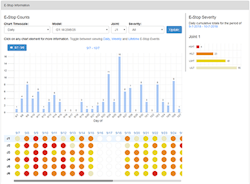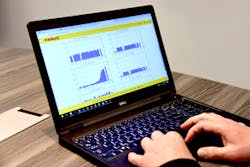The robot maintenance you're missing
In today’s world of the IIoT, everyone recognizes (or is learning) the importance of collecting and monitoring machine data to design a maximally accurate predictive maintenance program they can, and it’s especially true for robotic systems. Using data properly can maximize productivity and extend the robot’s life. However, with so much information out there, what is the right data to collect from a robotic system (and connected systems), and what does that data really mean?
With an ideal predictive maintenance plan, data should be collected by monitoring robots and process equipment and by tracking robot program and process changes. Then the information can be analyzed to compile operational insight reports and predict component failure. Using robot data to identify required maintenance tasks based on actual robot use will allow plant managers to reduce overall maintenance costs and schedule the most critical tasks during planned maintenance windows. The ultimate goal is zero downtime.
The most common maintenance work performed on robots includes troubleshooting issues with bearings and electrical components, oiling/greasing joints, and replacing cables that bend a lot during a robot’s operation. Maintenance needs often are identified by measuring temperature, vibration, harmonics and electrical current. These are all good data points to monitor for predicting failure.
Figure 1. By tracking the number of e-stop engagements, a problem could be pinpointed to a particular shift or operator and can be addressed before damage is done to machines.
With so much data being collected, there are three commonly overlooked areas that can have a big impact on productivity and robot life: cycle times, collisions and e-stops.
Cycle times
When a robotic cell is first installed, the system integrator optimizes it to run a job with maximum efficiency. Gradually, cycle times may increase, reducing productivity. Cycle times can expand for a variety of reasons: a change in raw material, a change of environment, a change in the machining process or tooling, the wear of a fixture ring or gripper, or operator interference.
Operators may “touch up” the program to adjust for line changes or with the idea that they can tweak the program a little to run things better. However, each touch-up can add seconds to cycle time, which can add up over months or a year.
If system data shows the original cycle time was three seconds, and later it’s five seconds, it can be easy to not take much notice. Only once cycle times are drastically different is the issue likely to draw attention, and by then that extra time likely is preventing the team from meeting production goals or has diminished the opportunity to reach higher production capacity.
There are many reasons why an operator may make a touch-up to a robot program. If a machine tool changes from a dull tool to a sharp one, it can move placement very slightly. It isn’t unusual for an operator to grab the robot’s teach pendant and move that point in the program. An operator may add another point in the system that allows for more clearance, adding another two seconds. With several operators and other workers touching the system over multiple shifts in a day, touch-ups can make a big difference over time.
Touch-ups are unavoidable, but the best way to prevent significant changes is to track cycle times regularly and take note of even smaller changes that can be traced back to a line adjustment or a particular operator. Continuous data collection makes this tracking easy.
Figure 2. Robot program touch-ups are unavoidable, but the best way to prevent significant changes is to track cycle times regularly and take note of even smaller changes that can be traced back to a line adjustment or a particular operator.
Collisions
Another commonly overlooked robot metric is number/frequency of collisions. A collision is any time the robot bumps into something that was not identified in the program. This can be caused by a change in the line, lack of operator care, or improper operator training.
Collisions cause a stall in the process, add to cycle times, minimize potential output, damage products, and contribute to premature wear of the robot and fixtures.
- See also "Robotics safety gets an upgrade"
An occasional collision is understandable, but if data indicates a spike in the number of collisions during a specific shift or specific time period, then it’s clear there is a problem to address. There are tools now available to measure collisions and report them on a weekly or monthly basis.
It’s a good practice to take backups of the robot program so that an operations manager can identify the last time the program worked properly and then revert back to that version of the program.
E-stops
Another often-overlooked robot data point is e-stops. Some operators misuse e-stops as a quick way to halt the process to make an adjustment or to go on a lunch break. The e-stop causes the brake to engage to a hard stop, causing undue strain on robot joints. When done repeatedly over time, it creates premature wear, leading to the need for expensive replacements.
Operators should be educated that e-stops are for emergencies only, and proper stopping procedures should be used for all other situations. By tracking the number of e-stop engagements, a problem could be pinpointed to a particular shift or operator and can be addressed before damage is done to machines.
The most effective way to prevent unnecessary wear and reduced productivity of a robotic cell is to track data points and use predictive analytics to identify trends and potential failures. That information will allow maintenance and repairs to be scheduled, avoiding unexpected (and expensive) breakdowns during production.
Using long-term trend data, advanced software algorithms can now provide condition-based maintenance guidance so that maintenance is performed only when it’s really needed, saving time and allowing plant operators to better allocate their resources.
Chris Voss is the national service manager for Acieta (www.acieta.com), a robotic system integrator and member of the Control System Integrators Association (www.controlsys.org). He is responsible for directing Acieta's field service team. Contact him at [email protected].


